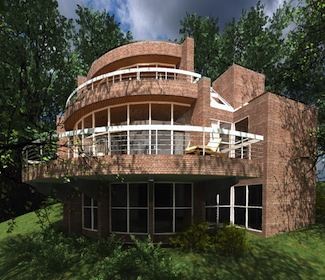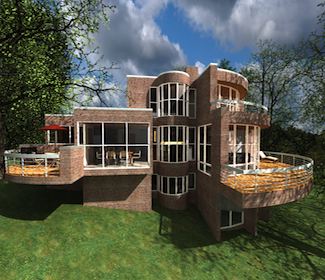Brick Veneer

Brick Veneer Used On a Home Exterior
As a building material, fired clay bricks have been around for thousands of years. Brick veneer was originally used as a load-bearing construction material, they are now typically used as an exterior cladding.
Brick Veneer: A Natural Choice for Green Homes
Fired clay brick veneer is the most popular form of earthen product in the U.S., and for good reason. Brick is an extremely durable, long-lasting product. A home's brick exterior will last for decades, if not centuries, with very little, if any, required maintenance. The classic, traditional look of brick adds a timeless quality and a solid feel to any home. For a green homeowner, the environmental impact of brick manufacturing needs to be looked at to determine whether brick is a suitable choice for a sustainable home.
Brick Veneer: Green or Not?
In searching for an answer to whether or not brick veneer can be considered 'green' or not, let's look at the manufacturing process, which is where most of bricks' environmental impacts lie.
Manufacturing Brick Veneer: Energy Energy Energy

The Versatility of Brick Veneer
Over nine billion bricks are manufactured every year worldwide. Making that much of anything is going to have impacts on the environment, and bricks are no exception.
Making the cement that goes into brick veneer and then firing them at very high temperatures requires a great deal of energy. Concrete brick manufacturing emits thousands of pounds of toxic mercury into the air each year, and the baking process releases a variety of pollutants. The whole process results in a finished product with significant embodied energy, which generally means that that product has a large environmental impact.
The large amount of energy required to make brick veneer is a negative, no doubt about it. But there are aspects to brick that act to offset that large initial outlay of energy.
Brick Veneer: Environmental Positives
The use of natural brick product for your home's exterior does have environmental benefits. Some of brick's sustainable qualities include:
- Locally-produced: Most brick products are produced regionally, which greatly reduces the environmental impacts of transporting such heavy materials over long distances.
- Use of Waste Materials: The high temperatures in the firing kilns allows bricks to incorporate waste materials, including toxic substances like oil-contaminated soil or manganese dioxide (a battery production byproduct) to be safely incorporated into the finished product. This diverts a fair amount of toxic materials from landfills.
Some brick manufacturers are now incorporating fly ash, a byproduct of coal power plants that is typically land-filled, into the manufacture of brick veneer. This reduces waste and has the added benefit of reducing the amount of energy required to make the bricks.
- All Natural Ingredients: The materials that go into making clay or concrete brick veneer are all natural; water, sand, clay, and other ingredients.
- Recyclability: Being natural products, brick (and leftover materials from their manufacturing) can easily be broken down and recycled into new products. Reducing landfill waste is an important attribute to any environmentally sustainable product.
- Maximum Durability: As mentioned earlier, brick veneer exteriors are built to last. Brick is naturally resistant to the harshest weather extremes.
Salvaged Brick: An Authentic Green Product
Salvaged brick veneer embody the true spirit of a sustainable product: It's natural, and it's reused. Reusing bricks from buildings or streets that would otherwise be scrapped eliminates all of the high energy usage required by new brick. Salvaged bricks can be used to give new homes an antique look, and are perfect for homes being built in older, historic areas.
comments powered by Disqus

























































































































































































